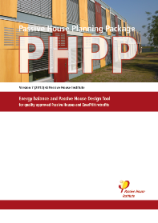Passive House Planning Package (PHPP)
Simply using Passive House components does not necessarily yield a Passive House

A Passive House is far more than the sum of its parts: precise planning is required in order to ensure that the components used work together to achieve the desired result. The Passive House Planning Package (PHPP) is the key design tool used when planning a Passive House and as such, serves as the basis of verification for the Passive House Standard. While there are other design tools on the market, it is the PHPP's high level of accuracy that sets it apart: energy balances can be calculated with the PHPP to an accuracy of +/- 0.5kWh!
Based for the large part on European norms, the PHPP makes use of numerous tested and approved calculations to yield a building’s the heating, cooling and primary energy demand, as well as its tendency to overheat in the warmer months. While the PHPP was developed specifically for Passive Houses, it is a design tool that may also be used for other buildings, including retrofits of historical buildings. Order the PHPP
Design PH – New 3D modelling tool for the PHPP

designPH is the new Trimble Sketchup plugin tool that works with the PHPP, inputting building geometry. The designPH tool allows users to model their Passive House projects in 3D. The benefits of the tool are two-fold; firstly it simplifies the process of entering data into PHPP and secondly, it provides preliminary feedback on the performance of the design within Sketchup.
designPH provides a variety of useful features including:
• The ability to work with a new or existing Sketchup model (some simplifications may be required)
• Automatic recognition of temperature zones, element types and area groups
• Schedules of areas, windows/doors and TFA components as well as recognition of external shading objects
• Rendering of heat-loss areas to indicate their area group or status
• Export geometry and shading data to PHPP via a PPP file, with conversion of elements to meaningful dimensions and quantities that can be manipulated in PHPP
• Tools to insert and edit window and door components, either with user-defined properties or from standard libraries
• Simple energy balances within the tool along with warnings as to high-levels of glazing that could lead to overheating
More information on designPH can be found on www.designph.org.
The new designPH modelling tool can be purchased through on www.passivehouse.com. iPHA members recieve discounts.
